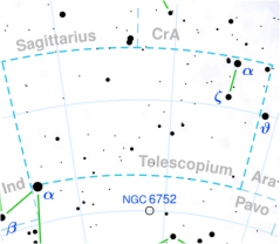Astronomy:HD 170873
| Observation data Epoch J2000.0 Equinox (celestial coordinates) | |
|---|---|
| Constellation | Telescopium |
| Right ascension | 18h 34m 31.11856s[1] |
| Declination | −52° 53′ 29.4756″[1] |
| Apparent magnitude (V) | 6.20±0.01[2] |
| Characteristics | |
| Spectral type | K2 III[3] |
| B−V color index | +1.27[4] |
| Astrometry | |
| Radial velocity (Rv) | 23.8±0.4[5] km/s |
| Proper motion (μ) | RA: −16.944[1] mas/yr Dec.: −42.325[1] mas/yr |
| Parallax (π) | 5.9179 ± 0.0283[1] mas |
| Distance | 551 ± 3 ly (169.0 ± 0.8 pc) |
| Absolute magnitude (MV) | −0.31[6] |
| Details | |
| Mass | 3.20±0.04[1] M☉ |
| Radius | 22.6±1.2[7] R☉ |
| Luminosity | 170±2[1] L☉ |
| Surface gravity (log g) | 1.86[8] cgs |
| Temperature | 4,473±122[9] K |
| Metallicity [Fe/H] | −0.01[8] dex |
| Rotational velocity (v sin i) | <1[10] km/s |
| Age | 318+30−31[1] Myr |
| Other designations | |
| Database references | |
| SIMBAD | data |
HD 170873, also known as HR 6954 or rarely 19 G. Telescopii, is a solitary orange-hued star located in the southern constellation Telescopium. It has an apparent magnitude of 6.20,[2] placing it near the limit for naked eye visibility. Gaia DR3 parallax measurements imply a distance of 551 light years[1] and it is currently receding with a heliocentric radial velocity of 23.8 km/s.[5] At its current distance, HD 170873's brightness is diminished by 0.39 magnitudes due to interstellar dust,[12] and it has an absolute magnitude of −0.31.[6]
HD 170873 is an evolved red giant with a stellar classification of K2 III.[3] It has 3.2 times the mass of the Sun but at the age of 318 million years,[1] it has expanded to 22.6 times the Sun's radius.[7] It radiates 170 times the luminosity of the Sun[1] from its enlarged photosphere at an effective temperature of 4,473 K.[9] It has a near-solar metallicity at [Fe/H] = −0.01[8] and spins too slowly for its projected rotational velocity to be measured accurately.[10]
References
- ↑ Jump up to: 1.0 1.1 1.2 1.3 1.4 1.5 1.6 1.7 1.8 1.9 Vallenari, A. et al. (2022). "Gaia Data Release 3. Summary of the content and survey properties". Astronomy & Astrophysics. doi:10.1051/0004-6361/202243940 Gaia DR3 record for this source at VizieR.
- ↑ Jump up to: 2.0 2.1 Høg, E.; Fabricius, C.; Makarov, V. V.; Urban, S.; Corbin, T.; Wycoff, G.; Bastian, U.; Schwekendiek, P. et al. (March 2000). "The Tycho-2 catalogue of the 2.5 million brightest stars". Astronomy and Astrophysics 355: L27–L30. ISSN 0004-6361. Bibcode: 2000A&A...355L..27H.
- ↑ Jump up to: 3.0 3.1 Houk, Nancy (1978). Michigan catalogue of two-dimensional spectral types for the HD stars: Declinations −53° to −40°. 2. Bibcode: 1978mcts.book.....H.
- ↑ Corben, P. M. (April 1971). "Photoelectric Magnitudes and Colours for Bright Southern Stars". Monthly Notes of the Astronomical Society of South Africa 30 (4): 37. ISSN 0024-8266. Bibcode: 1971MNSSA..30...37C.
- ↑ Jump up to: 5.0 5.1 Gontcharov, G. A. (November 2006). "Pulkovo Compilation of Radial Velocities for 35,495 Hipparcos stars in a common system". Astronomy Letters 32 (11): 759–771. doi:10.1134/S1063773706110065. ISSN 1063-7737. Bibcode: 2006AstL...32..759G.
- ↑ Jump up to: 6.0 6.1 Anderson, E.; Francis, Ch. (May 2012). "XHIP: An extended hipparcos compilation". Astronomy Letters 38 (5): 331–346. doi:10.1134/S1063773712050015. ISSN 1063-7737. Bibcode: 2012AstL...38..331A.
- ↑ Jump up to: 7.0 7.1 Kervella, P.; Thévenin, F.; Di Folco, E.; Ségransan, D. (October 2004). "The angular sizes of dwarf stars and subgiants. Surface brightness relations calibrated by interferometry". Astronomy & Astrophysics 426 (1): 297–307. doi:10.1051/0004-6361:20035930. ISSN 0004-6361. Bibcode: 2004A&A...426..297K.
- ↑ Jump up to: 8.0 8.1 8.2 Anders, F. et al. (August 2019). "Photo-astrometric distances, extinctions, and astrophysical parameters for Gaia DR2 stars brighter than G = 18". Astronomy & Astrophysics 628: A94. doi:10.1051/0004-6361/201935765. ISSN 0004-6361. Bibcode: 2019A&A...628A..94A.
- ↑ Jump up to: 9.0 9.1 Stassun, Keivan G. et al. (9 September 2019). "The Revised TESS Input Catalog and Candidate Target List". The Astronomical Journal 158 (4): 138. doi:10.3847/1538-3881/ab3467. Bibcode: 2019AJ....158..138S.
- ↑ Jump up to: 10.0 10.1 De Medeiros, J. R.; Alves, S.; Udry, S.; Andersen, J.; Nordström, B.; Mayor, M. (January 2014). "A catalog of rotational and radial velocities for evolved stars V: Southern stars". Astronomy & Astrophysics 561: A126. doi:10.1051/0004-6361/201220762. ISSN 0004-6361. Bibcode: 2014A&A...561A.126D.
- ↑ "HD 170873". SIMBAD. Centre de données astronomiques de Strasbourg. http://simbad.u-strasbg.fr/simbad/sim-basic?Ident=HD+170873.
- ↑ Gontcharov, George A.; Mosenkov, Aleksandr V. (28 September 2017). "Verifying reddening and extinction for Gaia DR1 TGAS main sequence stars". Monthly Notices of the Royal Astronomical Society 472 (4): 3805–3820. doi:10.1093/mnras/stx2219. ISSN 0035-8711. Bibcode: 2017MNRAS.472.3805G.
<ref> tag with name "Gould1879" defined in <references> is not used in prior text.
 |


